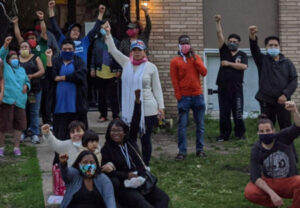
Where’s Pittsburgh Equitable Development Plan Months After Debut?
Civic leaders and other actors met with Pittsburgh residents and housing developers in order to create a policy brief –
Tostan works to empower rural and remote communities to bring about positive social transformation and sustainable development through a holistic empowering education program in Africa.
Carina Ndiaye and Danielle Manning of Tostan spoke with Lissa Harris on September 21, 2023. Click here to read the full conversation with insights highlighted.
Lissa Harris: Could you start off by introducing yourselves and describe the problem that you’re addressing and how you’re responding to it?
Danielle Manning-Halsey: I’m Danielle Manning-Halsey. I’ve been with Tostan for about six months now, I’m US-based so I lead our resource mobilization team, which falls under our partnerships team. We are a US-based unit, and I lead the philanthropic partnerships as well as strategic partnerships. I am looking to continue to partner with other organizations, so it’s not all about funding. This department is fairly new, a part of our new strategy. I’ll hand it over to Carina and she can tell you more about that work that we do.
Carina Ndiaye: I’m Carina and I’m the Chief Partnerships’ Officer at Tostan, and I’ve only been at Tostan for 10 months, but it’s a 32 year old organization that focuses on the vision that the community has for itself. At its heart, we’re in service of the vision board, literally the vision board created by the community in a 10-year span. We’ve done it in three iterations in some cases because we are 32 years old. When people ask me what is the problem that we’re solving, I like to say that we’re not solving a problem, we’re supporting a dream. It’s really about understanding what the communities that we serve in Senegal, Mali, Guinea-Bissau, Guinea, Conakry, Gambia today, what they aspire to be. It’s very different from what you or I would aspire to be as full human beings, members of a community in a collectivist society.
We work on providing basic principles of human rights, which we call principles of human dignity, and infusing that in a three-year program that has capacity building elements to it in governance, civic engagement, basic health practices, peaceful resolution of conflict, open dialogue, what holistically looks like, what project management skills looks like, what agricultural basic practices are. We work with a group of the community called the CMC, the Community Management Committee, which is composed of 60% women, and it’s a leadership group elected by the community that has subcommittees that head or lead or consolidate the efforts around child welfare, education, access to water. The committees have their own domain of interest and influence, and they work together to represent their communities to the exterior, whether it’s the municipalities or whatnot.
We are in service to the expertise that the community has about what their wellbeing means. What we find happens as a result of this open dialogue, this non-judgmental and human rights based approach, is that the community members start questioning what they’re doing and the dichotomy of rights and responsibilities. When you talk about at a global level, you have a right to be safe, what does that mean? As a part of the community, it is your responsibility. It’s the dialogue that then is opened up around questioning whether they are embodying the values that they’ve espoused before we even showed up and the values that they seek to reinforce, that’s our work.
Lissa Harris: What is your focus in terms of geography or types of community that you serve?
Carina Ndiaye: Geographically we are in direct implementation in five West African countries, one is francophone and one is anglophone. But we are in strategic partnerships, which is what Danielle was talking about with this new strategy. We are working in strategic partnerships with five English-speaking countries in the region, including Kenya, Liberia, Sierra Leone, Nigeria, and Ghana. Part of our program is not only to be in the community, it’s also to create communities of alumni that come to our Tostan training center. Our method has been tried and true and is constantly evolving to reflect changes- post COVID, Ukraine, climate change. Our curriculum changes and adapts to what the community’s needs are. We also have a built-in alumni network that then becomes its own community and can take and scale and self appropriate what we work on, the program that we have. So to answer succinctly, we are really in West Africa, but through strategic partnership and through our community of practice, our work is worldwide. It’s not just even African, the communities that we serve are the communities of the world.
Lissa Harris: Would you say that most of your work is direct service to people in the community or are there other beneficiaries that you’re serving, whether that’s community organizations or other entities? Can you just talk about the people that benefit from your work and the organizations that benefit from your work? Who are they?
Carina Ndiaye: If I take it from the training and the sharing and learning aspect, it would also be other NGOs, local officials, elected leaders, religious leaders, because they represent the key aspects of the stakeholders in the region that we serve. They also have been trained and continue to be trained in our methodology. Then we have a direct impact on the community members that we serve, 10 at a time and you have about 13 members per class. People directly in the community are benefiting, but we can’t do this work without the entire national and regional ecosystem. We have direct implementation, so beneficiaries that get the certificate that says they have graduated or they’re part of our program, but we also have the whole ecosystem that either is directly trained by us or benefits through the ease of insertion of social programs because we are in the community.
Lissa Harris: Can you talk a little bit about the specific benefits that the people in the organizations that you serve are getting from your work?
Carina Ndiaye: The number one realization or aha moment people have when they come is that the driver of the program is the community. The solution is where the issue is. Our founder, Molly Melching had this realization 32 years ago that there is absolutely no sustainability in change if the architects of the strategy aren’t the actual people trying to aspire to more.
There’s also the aspect of non-judgmental approach. Even though Tostan is known for participating in the movement of abandonment of practices that are not good for children, and also the ending of FGC or the declaration and intent to end female genital cutting in the region, it’s actually not what we do. We don’t have a FGC program. The outcome from the ability to talk, so everybody getting a seat at the table, that is for the community. Putting the emphasis on the wellbeing of the community as a whole has allowed us to have these outputs of breakthrough realizations and us being invited to declarations. We’re not the ones organizing in all of the communities, in The Gambia, for example, where they publicly declared that they are ending FGC in their community. It’s not us. We are guests and we are service providers. It’s the element of creating a space where men and women are equal partners in the creation of well-being. It’s learning, it’s been a learning journey. We don’t go in talking about women’s rights or human rights. In my language, for example, there are words to talk about human dignity, but not human rights. Even understanding what the contextual aspect is in service has been great.
The third aspect that is key is that all of our programming is done in local languages. That has been something that I think everybody has either adapted, adopted, or integrated into their understanding when it comes to the level of respect we have for the communities that we serve.
Lissa Harris: That leads pretty nicely into my next question and I feel like you’ve answered some of it here, which is, what makes your approach distinctive from other organizations that might be serving similar communities or doing broadly similar work?
Carina Ndiaye: The first one would be the fact that the facilitator of the program is accepted by the community. He or she doesn’t have to be a member of the community, but at least a member adjacent because there are cultural aspects in tackling certain issues, in creating a safe space. You can’t really be an outsider. So I couldn’t go to the villages that are outside of my ethnic group and say that I would facilitate a three-year program that would touch on very sensitive and culturally impactful topics. There’s that level of carefully curated invitation and insertion into the community, and that goes into the language and all that.
The other aspect I would say is in terms of the organizational values, and this is my first time in almost 20 years in development, seeing an organization that puts on their website humility and love as part of the organizational values. At heart, our programs started because someone loved the communities that welcomed her, and that has been transversal. That is the essence of who we are. When you love someone, you not only have respect, but you also want to learn from the person, right? In general, a healthy loving relationship is an exchange, and we’ve learned as much as we’ve shared. So those to me are the fundamental differences in our program. I’m not saying that others don’t love the communities that they work in, but as opposed to the implicit aspects of our program, that is an explicit value and demonstrated issue for us. We love them.
Lissa Harris: Can you share an example that shows the impact of your work at the community level?
Carina Ndiaye: I have many, but let me try to summarize one that has been publicly shared, so I don’t feel as if I’m violating anybody’s privacy. During my onboarding, we went to a village to celebrate the launch of our new strategy called In Partnership for Community Development and Wellbeing. The chief of the village stood up in front of, I would say about 200 people, and said, “I used to be physically abusive to my wife.” And all of us looked at each other very uncomfortably like, okay, that’s kind of odd, but what he was getting at is when I was physically abusive to my wife, it’s because I wanted to protect her. I felt like that was my role and I was taught that the head of household is to be obeyed and respected and the two are equal. Through the dialogue and the sessions that he had while participating in the program with his wife, he discovered that what they were both concerned about was her safety coming back from the market, very basic, the roads are not paved.
She came back late and he was always upset that she was at risk on the road and she was also not comfortable coming back so late. What they had found as a solution was for her to take a cab so she wouldn’t get into an argument with her husband, but when they calculated, they did a cost benefit analysis, they realized that what she was making, she was losing in transit. So what was then a solution that together they would be comfortable with? It was finding a family member in that community where she was selling her wares where she could spend the night if she finished late, so that in the morning she could come home, they had the money and they had no conflict. This man was telling us this story because he was [initially] uncomfortable with letting his wife go 20 kilometers away, but he let her go for a program in India for six months to learn how to be an engineer in solar energy.
Not only did it benefit her and their community, she then became a trainer for the adjacent communities and has traveled in the region to train people on these very basic skills. She doesn’t know how to write and she doesn’t know how to read and she doesn’t speak English, French or any other language. So he was telling us that, to him, that was the value of the program – the ability to have a peaceful home. In our latest report we found that the relational is truly the key transformational aspect of our program. At heart, people are more at peace with themselves, with their bodies, with their communities, with their spouse, and with their children. Those relationships changing gives them the breath and the flexibility to be innovative and the tools to resolve issues that have to do with water or electricity, et cetera.
Lissa Harris: Can you talk a little bit about insights that other organizations or other people working in your field could take from your work? What can we learn from your work?
Carina Ndiaye: We’ve been doing this work for 32 years and at heart we’re not infrastructure based. Really understanding what is the essence of what you’re contributing to the communities that you serve. And in order to do that, you have to listen to the community because certain things will then start being recurrent, right? Where you can actually build an engagement strategy around issues and concerns that are regional or community-based so you won’t be doing a la carte interventions. If you really listen to the community, you will see that transversely in this region, they’re worried about the 1, 2, 3. That would be my first insight.
The other insight might be actually a point for reflection for all of us, it is how do we work ethically and respectfully in partnership? We can’t do our work by ourselves, and the community can’t be developed as they seek to be developed without subject matter experts, financing, strategic partnerships, influencing and amplifying. At times we’re very competitive in our ecosystem because resources are limited and the work and the needs are many. So it hasn’t been easy, but focusing as much as we can on how to build strategic partnerships where the impact and those KPIs [key performance indicators] that donors want can be reflected in what the community has achieved, not what we think the community should achieve. So those would be maybe the two things. I don’t know, Danielle, if you have anything to add about what we can share?
Danielle Manning-Halsey: I would just say always remembering that those that are closest to the challenges or issues are the ones that are closest to the solution. So always being in a place of listening, learning, and sharing.
Lissa Harris: You talked about KPIs that are important to your donors, but what about you? How do you measure your success? What’s the evidence that you use to see that you’re making progress?
Carina Ndiaye: The most graphic one or visual one for me was attending a community meeting where they stood besides their three vision boards. So there are actual vision boards that are painted and drawn at the beginning of the program where the community puts in their own language what are the things that they aspire to have within the next 10 years. Seeing members of the community management committee standing next to three iterations of that vision board, you see how they’ve gone from wanting one hospital to a hospital that has a certain machine to a medical complex that also addresses the needs of pregnant women and children. You see it in pictures. To me, that has been the epitome of success. The ability for the community to take ownership over their own development and not just with us, because obviously we don’t build hospitals and everything.
The second one would be the increased demand for our program. The demand far exceeds our ability to do so, and that’s part of our work in doing resource mobilization. It’s the demand that comes from governors, from ministries of health, from other types of ministries, because they say that when we’re in the community, it facilitates and it permeates their work. Certain practices, a certain openness, a certain regularity, a certain civic engagement, it makes their job easier.
We’re often asked if you empower the community, does that mean that you then create conflict with local authorities? Because some people assume that the imperfect political system wouldn’t support more accountability, but part of the lack of accountability is a lack of bandwidth. I’m not saying there’s no corruption, but truly it’s what we’ve heard over and over. In that sense, I would say that’s the challenging success that we have today. After 32 years, we are really trying to find as many resources as possible to respond to the demand and make ourselves leaner and leaner so that most of the resources that we have go directly to our beneficiaries.
Danielle Manning-Halsey: To the communities. I would add to that, to say that one measure of success for the communities is the communities themselves having agency and being able to advocate for themselves, and not only just for their communities. We have many women that have served on the CMC committees that have become elected officials, and so they’re now serving their community and other communities. It’s an extension of the program and so that, to me, is success when you can advocate for yourself and you understand your rights.
Lissa Harris: Innovators sometimes learn as much from things that don’t work as things that do and I’m wondering if you can describe something that you tried that didn’t work and what you learned from it.
Carina Ndiaye: The first one would be the language issue and the fact that when we first started, we were trying to… not cushion, but we were articulating our focus around women’s rights and what it created was an unnecessary resistance on the male part that said, what does that mean? It’s the same conflicted reaction you sometimes get when you mention toxic masculinity. What you’re doing is lumping allies and potential allies into a group and creating a tension that may not have to be there. So language has been extremely important for us. Even calling again, female genital mutilation. Mutilation, we changed that to cutting because of the translated word in local languages. So that is where we had a lot of lessons and we keep learning. What is today appropriate in the language?
Molly always talks about a very well-intentioned project that was fully funded, that was a community garden, and everything that the community seemed to be on board with. We did the proper social, “hello, can we? Would you like?” And everything. But then nobody attended to the garden. And when she asked, “What’s the matter?” They said, “This is not how we garden. This is not how we plant. Because of the way we’re organized, this is how we do it.” And she was like, “Why didn’t you say anything?” And they said, “You didn’t ask us.” So asking to do something when coming with a fully formed plan is not always the answer. Co-creation is key. And the reason why a strategy is embraced by everybody is because we spent a year in focus groups with all of the members of our ecosystem talking about what we should be doing next.
Lissa Harris: You learned you can’t come out talking about women’s rights from the outset, but you have a committee that is formed of women and this process seems to be very female led. How do you navigate that? Can you talk a little bit more about the reasoning behind having the women lead this process?
Carina Ndiaye: There are implicit truths that in most communities when you come into the community and you have meetings or inter-village meetings, the women speak less if at all. So in trying to create a dialogue where everyone feels seen, we have been able to justify saying, if we’re creating this program for the entire community, we need to have everybody present. We pushed it a little bit by saying 60% women, right? Because a lot of these areas are women led and that’s the implicit truth. Who looks after the kids in school? It’s usually women. Who is in the field with the crops? It’s usually women. So I don’t think it was a stretch to say in these committees there should be majority women. What ended up happening is that the women became the leaders because in each subcommittee there’s a head of the committee or subcommittee and there’s an assistant.
There’s a governance system where certain things are happening. And what I saw that blew my mind was that in the communities that we visited during our onboarding, the chiefs of villages were assistant to the women. One of them was in the health committee and he proudly said it. As an African woman who grew up there, I couldn’t reconcile what I was hearing and what I was seeing because culturally the head of household is a man. That positioning is again, very culturally anchored. So to see this man introduce himself sitting at the table, because we were sitting at the guest table and facing the CMC in the circle, and he said, my name is so-and-so. I’m the chief of the village, welcome, and I am the assistant to the health committee lead madam.
Then to see Imams, who are our highest religious leaders in a Muslim country like mine, to see Imams say, hello, my name is so-and-so welcome, pray, and then say, I am the assistant to the environment. What you realize is that the reason why I’m concerned, or it made me tick, is because I think there’s a power dynamic, when in their mind there’s a service dynamic. It’s not about them, it’s not about their position, it’s about their children, their trees, their waters, their fish, their everything. It’s about them. And one thing that I also want to highlight, which I also shared with the community, is that without the seed already being present, this would not have been possible.
When you look at the CMC members, you see very specific personalities. You see the artists, you see the analysts, you see the extroverts who are in the social mobilization team. These people were already how they are. They were natural-born leaders, each with their own type of intelligence. This dialogue has created an enhancement and an ability to actually blossom in who they are authentically. So the introverts are usually the accountants in the CMCs and they’ll bring their book to you, their accounts, they’ll tell you exactly to the cent how much is in the account. The social mobilizers are the ones that will take you the guests and start dancing with you and make you feel like you’re a part of the community. That natural enhancement of what was already there or under the surface is to respond to your other question, for me personally, another KPI of success. Allowing people to be their full and authentic selves within their community.
Lissa Harris: I want to talk about challenges that you’re facing and leaving aside the issue of funding, because that’s always an issue no matter what your work is. Are there challenges that you haven’t yet been able to overcome? Are there areas you’re not able to serve or is there some sort of access or opposition issue or public reception issue that you really haven’t been able to overcome yet?
Carina Ndiaye: Because I believe in the power of words, I’m not going to say that we haven’t overcome. I’m going to say that we are swimming through. The number one speed bump, that’s what I’m going to call it, speed bump, is the fact that our program is holistic. People tend to internalize change and development in very specific silos and categories. Are you providing medical supplies? Are you responding to a humanitarian crisis? Are you working on social norms? And one in particular, are you looking at climate change? And we do a little bit of everything, and our program is non-formal. At the inception of our program, there’s an element that is an amoeba of support. So trying to proactively seek partnerships, whether they’re financial or strategic, can be challenging at times because for a long time, Tostan is old-ish, but a lot of people who know Tostan are friends whereas other people don’t know.
Our brand hasn’t been as widespread as you would think because the group of people who understood it most likely came to the community and saw, or they read the book. There was a very, not elite, but elitist group of friends, and today we think the model can really be shared and is ready to be amplified because the rest of the world has caught up to what Molly discovered 32 years ago. The global south is in. Community led development is in. But the challenge is people still want the new awareness to fit within the old model, so at times it’s hard to get people to understand the value of holistic.
Lissa Harris: Could you talk about are you working to advance systems level change, and if so, how are you doing that?
Carina Ndiaye: It’s always been about the system because the communities and the services that compliment the work that we do are at the municipal level. One of the modules that we work on is civic engagement, and the first thing that we recommend and we encourage is the payment of taxes through the CMCs, which then allows you to have access to certain services. The registration of births, it’s the number one thing that the communities we visit want to show you. They actually physically take all their birth certificates laminated or not, and they bring them and say, all of our children are registered. That allows the children to go to school, so in order to have that fluid relationship between what is your identity as a member of a national community and a member of your geographic community, there needs to be a dialogue and an understanding of what your responsibilities and rights are at the national level.
We have been working with the decentralized governments because in the areas that we serve, a lot of the social services are decentralized because the populations that we serve are extremely remote. There’s always been a dialogue between the community and with us and the local government. What we’re finding now is that even at the national central level, our model is being not only recognized but wanting to be emulated and also at the regional level. We’re finding that they think that this works because it’s a complimentary system where, with or without Tostan, the community becomes its own sociopolitical engine of change.
In this next iteration of our strategy, one of the key indicators of systems change is the creation of the Children’s Municipal Council. There’s actually a decision making and decision informing engine that is reinforced through our programming where young people have a say in budget allocation and strategic priorities. Young people actually have a council that is advising the municipal authorities on what the priorities should be when it comes to development. Those kinds of initiatives, they’re not ours, but what we do reinforces them.
Lissa Harris: What do you think is most needed from other actors or partners you’re working with to advance this kind of system level change?
Carina Ndiaye: Trusting that it’s not about how much, it’s about how. If you’re going to invest and you should really, I think as a collective, we all belong to a community. Investing in our communities should have a certain level of trust because that will help create sustainable change that is a win-win for everyone, whether it’s the private sector, the medical sector, governments, civil society organization, the press, we all work together to build community, not to squeeze it into what we perceive to be a temporarily fix. Trust, for me, is the number one thing because we are exchanging my citizenry for your funding, for example, at the government level. Climate change is affecting all of us in major ways, but when you go into the community, they don’t talk about climate change, they talk about their crops, they talk about the fish, the water, et cetera, the rains.
Trust and dialogue is the number one thing. The second one would be complementary intervention. That’s not just an issue for NGOs or for governments. Making sure that the initiatives and the partnerships that are being formed are not redundant or parallel, but really operating within a matrix, which is the model of success for most big companies to date, there’s a matrix like operating system where there are touch points, but there are also areas of breadth for people to specialize in whatever it is that they do.
Lissa Harris: How do you see your work evolving over the next five years?
Carina Ndiaye: I see even more sharing and learning because even though we are 33 years old, we can learn from other people, we can learn from other organizations. We’re also actively working on bringing more of a youth strategy or youth infused energy to our programs, to our intervention, and also to our design engagement in the community. The youth are leading a lot of the change. If you’re looking at financing and personally as chief partnerships officer, I’m hoping that I can have enough to continue this work in the community, but on the other side, create a movement that isn’t financially bound. Learning truly from each other, best practices, innovative light touch approaches, I think that’s where sustainability is.
Lissa Harris: Is there anything that we didn’t cover that you think is really important to make sure we add here?
Carina Ndiaye: The number one thing would be encouraging all of us to truly look at partnership versus competition, because especially being in these merry-go-rounds of donors and strategic partners and everything, people are as guarded as they’re open. It would really benefit all of us to understand what the common ground is and where we can work together. And that takes stepping out of your organization and your needs and looking at in this region, on this issue, what needs to be done and how can I bring in my grain of salt together? It goes in the supply and demand chain in terms of donors also being creative enough to say, this is what we would like to do and we hope we can support. I think it’s growing a consortium of organizations working towards this and not creating a system where we’re almost automatically pitted against each other because we’re competing for the same resource pool.
Lissa Harris: Thank you both so much for your time and your insights, and thanks for contributing to this project.
Click here to read the full conversation with insights highlighted.
Lissa Harris is a freelance reporter and science writer (MIT ’08) based in the Catskills of upstate New York. She currently writes about climate, energy, and environment issues from a local perspective for the Albany Times Union, her own Substack newsletter, and various other digital and print publications.
* This interview has been edited and condensed.
Learn about other social innovations working in Africa.
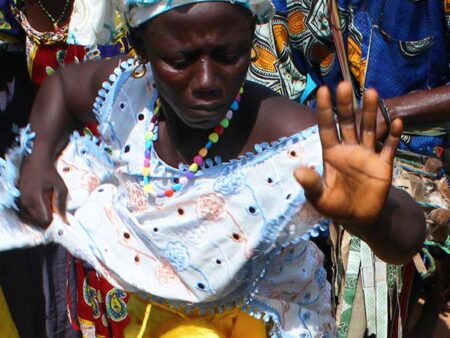

Civic leaders and other actors met with Pittsburgh residents and housing developers in order to create a policy brief –
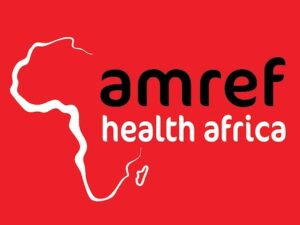
Community health workers, trained by Amref Health Africa, bring much-needed primary and preventive care to their communities. Read the interview

Native Americans in Philanthropy is a Native-led organization that promotes equitable and effective philanthropy in Native communities. They support several
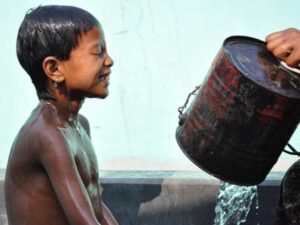
Water.org and WaterEquity help people get funds to improve their water and sanitation systems. Gary White of Water.org and WaterEquity
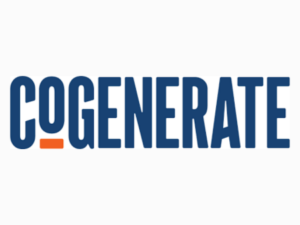
CoGenerate seeks to bridge the divides between people of different ages, by bringing older and younger people together to solve
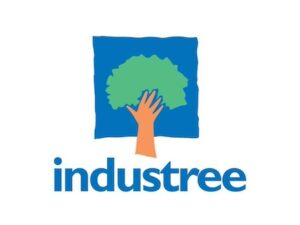
Industree Foundation works at the intersection of equity, gender, and climate by focusing on training women to adopt green business